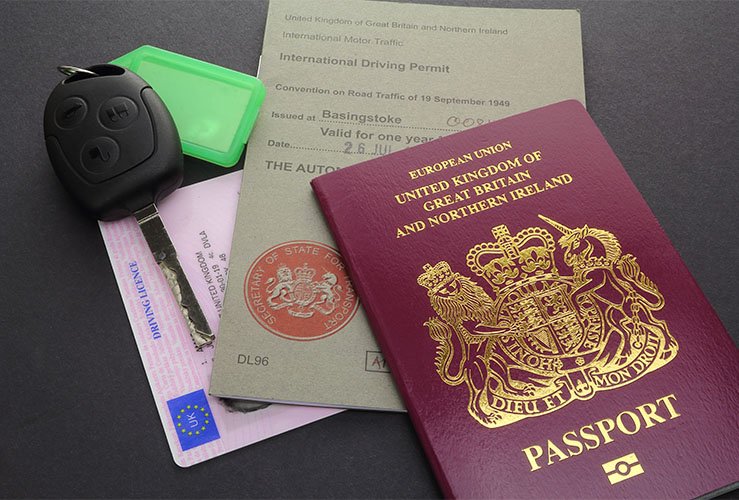While the UK technically left the EU on January 1, 2020, the 12-month transition period meant the UK adhered to EU rules and remained a member of the single market. It also meant UK motorists could drive in the EU in the same way they had done in preceding decades.
However, with the transition period having ended in January 1, 2021, UK drivers heading to the EU must now adhere to new rules.
Here we take a look at what the changes are when driving in Europe after Brexit.

If you’re planning on driving in Europe post-Brexit, we have you covered! Start Rescue still provides breakdown cover through our partners on the continent, for trips to Europe from one to 31 days.
European breakdown cover from Start Rescue covers all 27 EU member states, as well as non-EU states like Andorra, Switzerland and Vatican City.
Find out more and get covered here.

Will I need an International Driving Permit (IDP) to drive in the EU?
When driving in the EI post-Brexit, you will not need an international driving permit (IDP) for short trips* if you have a full UK (Great Britain and Northern Ireland) photocard driving license.
But if you only have a paper version of your license you will need to get an IDP.
*‘Short trip’ is considered under 30 days, under 90 days, or under 6 months, depending on your destination country. More information here (Gov.uk).
Do drivers from Gibraltar, Guernsey, Jersey or the Isle of Man require an IDP to drive in Europe?
Residents of Gibraltar, Guernsey, Jersey or the Isle of Man may be required to have an IDP. Contact the embassy of your destination country to find out if you need one.
Where can I get an IDP?
You can purchase an IDP over the counter at most Post Offices for £5.50.
What do I need to get an IDP?
Aside from the fee, you need a valid Great Britain or Northern Ireland driving licence. You must be a resident of Great Britain or Northern Ireland.
Which IDP should I buy?
There are three types of IDPs:
- 1926
- 1949
- 1968
However, European countries require either 1949 or 1968 IDPs (some countries - like Austria and Bulgaria - do not require an IDP).
You must have the right IDP for your destination country. Check the UK government website for more information about which IDP you need.
Is it easier to get a photocard license rather than an IDP?
If you only have a paper licence, you can exchange it for a photocard version for a fee of £20. You can apply for a photocard licence online (the easiest option); by post; or in person at the DVLA in Swansea.
If you plan to drive in Europe often then getting a photocard license could make sense. On the other hand, you can obtain an IDP over the counter at a Post Office straight away - good if time is limited.

IDPs: Driving in the EU for “longer” periods (30+, 90+ days or 6 months, depending on country)
You may need an IDP if you plan to stay in a European country for a longer period.
“Longer period” in this case depends on the country being visited. For example, if you drive in Cyprus for more than 30 days, you’ll need a 1949 IDP; in Denmark, you can drive for up to 90 days without an IDP; and in Belgium you can drive up to 6 months without an IDP.
It should be noted that as a UK citizen you can only stay in the EU for periods of up to 90 days in any 180-day period, so the issue may not be relevant.
Can I use my UK driving licence if I live permanently in the EU/EEA?
No. You cannot use your UK driving licence if you live permanently in the EU/EEA. You must apply for a local driving licence.
Is my UK driving licence valid for driving in the EU/EEA?
Yes, most UK residents with a UK driving license will be able to use it to drive in the EU. However, those with paper licences or with licenses issued by Gibraltar, Guernsey, Jersey or the Isle of Man may need to get an IDP. If you are in this group, check with the embassy of your destination country for more advice on which (if any) IDP you need.
Can I still use my UK driving license with the EU stars on it?
Yes. All UK driving licenses issued while the UK was a member of the EU are still valid (so long as the expiry date has not passed). These licenses feature “UK” ringed by EU stars.
Can I still use my old burgundy UK (EU) passport in Europe?
Yes, you can still use your old burgundy UK passport (with “EUROPEAN UNION” on the cover) for trips to the EU - assuming the passport has at least 6 month’s validity, and is less than 9 years and six months old.
Of course, the old burgundy passport is also valid for everywhere else in the world, under the same provisos that existed before the UK left the EU (chiefly - in most cases - that it has at least 6 month’s validity and you have the required entry visas).
Do you need a Green Card to drive in Europe?
Initially upon leaving the EU, it was announced that UK drivers would require Green Card insurance to drive in the EU after Brexit.
However, the European Commission took the step to scrap the Green Card requirement in the summer.
As of 2 August 2021, there has been no requirement for UK drivers to get Green Card insurance to drive in the EU, EEA, Switzerland, Serbia or Andorra,
Do I need to take a vehicle registration document to drive in Europe?
Yes, when driving to Europe from the UK you need to take either your V5C vehicle log book (if it exists), or a VE103, which proves you're permitted to drive a leased or hired vehicle overseas.

Hiring a car overseas: Vehicle on Hire Certificate
if you're renting or leasing a car in Europe, the providing firm will normally supply a "Vehicle on Hire Certificate" - in lieu of the original Vehicle Registration Document.
UK sticker (Previously GB stickers)
Since 28 September 2021 it has been a requirement, when driving to Europe from the UK, to display a UK sticker when driving in any of the 27 EU member states.
The UK sticker replaces the GB sticker previously required to drive your vehicle in Europe.
If your number plate includes the UK identifier with the Union flag (also known as the Union Jack), you do not need a UK sticker, apart from if you are driving in Spain, Cyprus or Malta, where you must display a UK sticker no matter what is on your number plate.
Driving in Europe post- Brexit: What are the rules on travelling with pets?
If you have a pet passport issued in Great Britain it is no longer valid in the EU or Northern Ireland.
Great Britain, the Channel Islands and the Isle of Man is regarded by the Eu as a Part 2 listed third country under the EU Pet Travel Scheme.
In order to travel with your pet (dog, cat, ferret) to the EU or Northern Ireland, the animal will need:
- An animal health certificate (AHC) from your vet (at least 10 months before departure).
- To be microchipped
- A rabies vaccination (at least 21 days prior to departure)
Further information: https://www.gov.uk/guidance/pet-travel-to-and-from-great-britain

Having a collision in Europe post-Brexit: How do I make a claim for an accident when driving in Europe post-Brexit?
If you have a road traffic accident in Europe, contact your UK insurer in the first instance.
If another driver is at fault, as a UK resident you may need to make a claim with their insurers.
If an at-fault driver flees the scene or is uninsured, you may not be able to make a compensation claim at all when driving in the EU after Brexit. The UK government has stated that UK residents "should not expect to be able to make a claim in respect of that accident via a UK-based Claims Representative or the UK Motor Insurers’ Bureau (MIB)’."
Speeding fines issued in EU: will offenders be pursued?
Now the UK has left the EU, the Cross-Border Enforcement directive does not apply to UK drivers in the EU. So if a UK driver gets caught speeding by an EU speed camera, they cannot be pursued for the fine. Equally, EU drivers caught speeding by a UK camera cannot be pursued for the subsequent fine.
However, a driver may still be landed with a fine for speeding whilst driving in the EU if:
- The driver is caught speeding in a hire car and the hire firm pursues them for an admin fee
- The driver is issued an on-the-spot speeding fine in the EU
- French authorities find a way to re-impose the Cross-Border Enforcement directive between the UK and France (a similar agreement exists between France and non-EU Switzerland)
Before embarking on your European road trip, we recommend carrying out some pre-Euro trip checks, to help ensure your car is in good working order.
You should also ensure that you have suitable European breakdown cover in place.
Start Rescue provides a range of European Breakdown Cover options with 1, 4, 9, 16, 25 and 31 day packages covering your vehicle in over 40 countries. Make your holiday or business trip as stress free as possible by ensuring your vehicle is covered should it run into difficulties, whether you are travelling in a car or on a motorcycle. You can find out more here.




